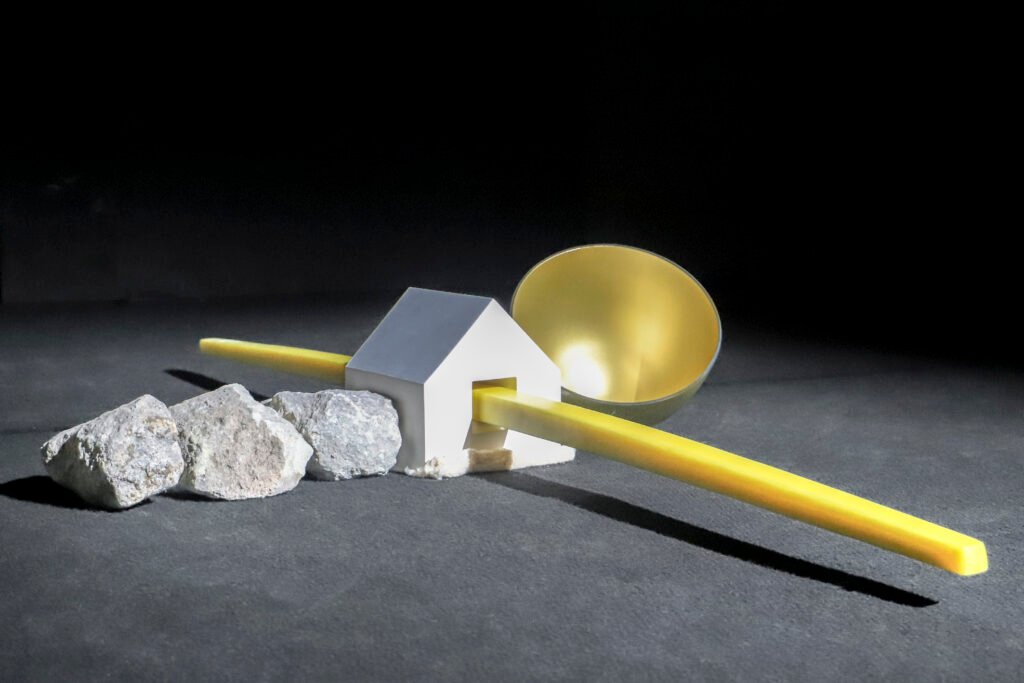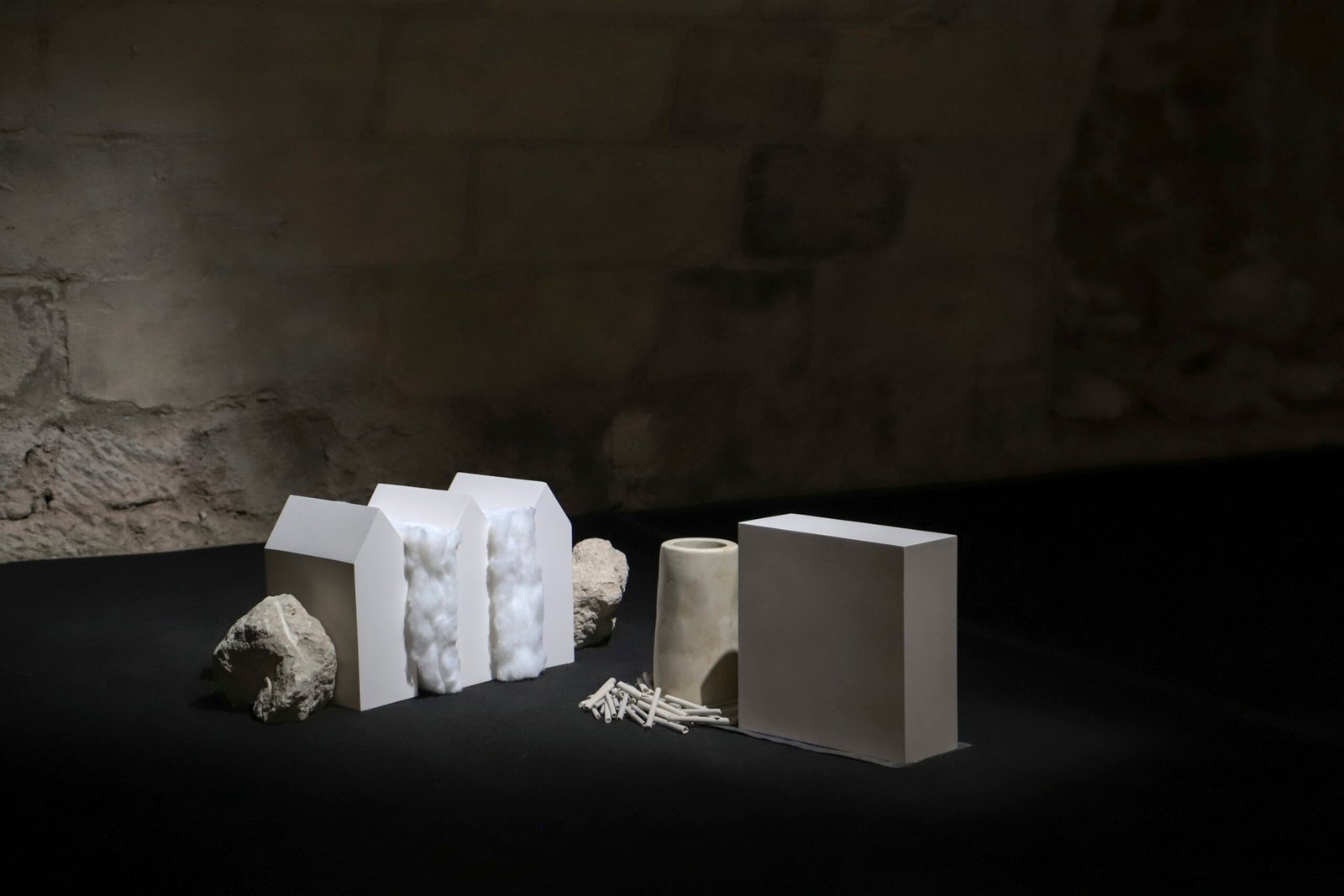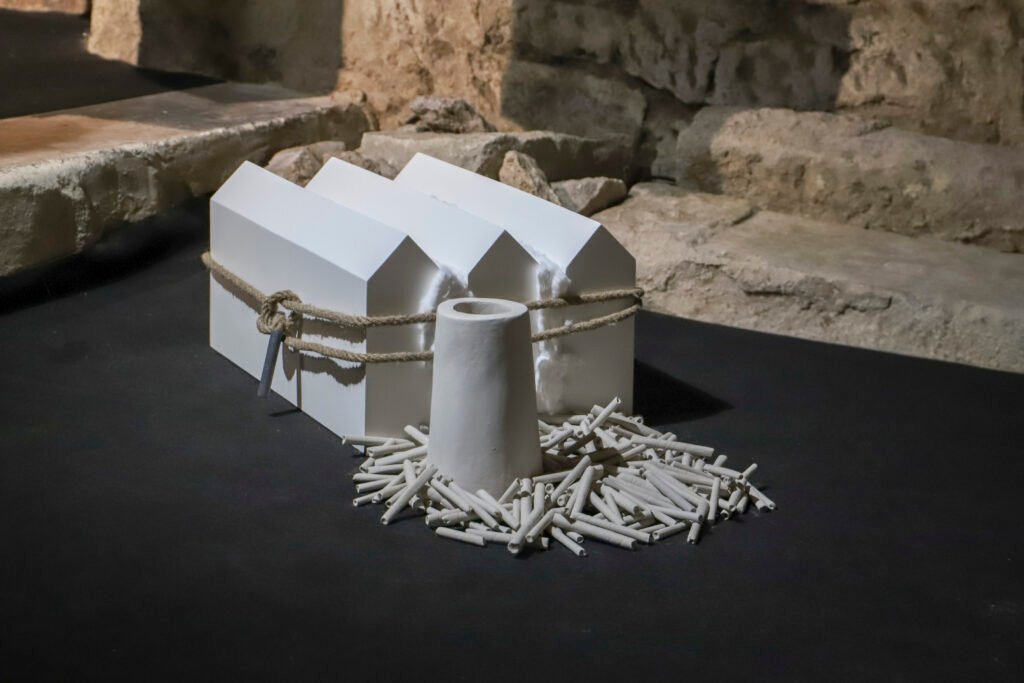
The Pierced House: A Topography of Fragility
What strikes first is the silence of the form. It seeks neither to seduce nor to impose. It waits, resting on the ground, in a posture of withdrawal. And yet, everything within it is tension.
The white house, reduced to its essential geometry, becomes here a symbol of intimacy. It is not inhabited—it is a shell, almost clinical. Its whiteness is not that of purity, but of the unspoken, the neutral space where stories are projected. It rests on a small cotton mattress, a soft, absorbent material that evokes both care and abandonment. It is a bed, a cloud, a cushion for falling.
But this house is pierced. A long, thin, sunlit needle of beeswax penetrates it like a slow arrow. The gesture is surgical, yet without violence. The wax, a living and unstable material, does not lacerate—it opens. It introduces a temporality: that of slow perforation, of light passing through the symbol. The needle becomes a vector, an axis, a direction—but also a wound. It transforms the architecture into a vulnerable body, a space traversed by an invisible intention. At its tip, a hollow ovoid half-sphere in golden glass, resembling a solar spoon, rests against the wax. It acts as a sacred counterpoint. The gold evokes relics, the precious, but the glass remains fragile, breakable. This wax-glass duo composes a silent liturgy, a kind of ritual without dogma, where light becomes matter, and the house, a place to be traversed rather than a refuge. Three stones, placed side by side, hold the whole in a silent tension. They are not there to stabilize. They are presences, guardians, witnesses. Their arrangement evokes a form of triad: past, present, future; body, spirit, memory. They do not support—they watch.
Finally, the fact that the whole is placed directly on the ground is fundamental. It rejects monumentality, the altar, the pedestal. It belongs to a topography of fragility, an aesthetic of horizontality, where the work becomes almost a reclining body, a lying form, a wounded but offered architecture.
It is not a house—it is an incision into the symbol. An attempt to pass through without breaking. A work that speaks softly…

Houses and the Hollow Hearth
« A warmth that never comes, a word that never escapes. »
Three narrow white houses stand like silent figures. They resemble one another, yet do not speak. Between them, cotton: soft, absorbent, almost suffocating. The cotton does not connect—it separates. It isolates the forms in a suspended state of waiting. From each cotton mound, two raw stones emerge, like anchors or obstacles. They frame, they freeze. These are blocks of memory, mute resistances. Facing this trio, a rectangular structure holds the hollow imprint of an absent house. It is the inverted trace, the negative of a shelter. It contains nothing, but it points. It is a sculpted absence, a ghost form.
Just in front, a chimney made of raw, white, naked clay—without fire. It is a mouth without speech, a hearth without warmth. It evokes the domestic center, but in a state of waiting, of non-event. The unfired clay refuses completion. It remains open, fragile, ready to fall. At the base of this chimney, a multitude of small raw clay cylinders. Scattered, repeated, insistent. They are frozen breaths, attempts at language. Each cylinder is a unit, a voiceless word. Together, they form a grammar of silence, a soundless score. All these elements—the chimney, the cylinders, the hollow structure—are placed on a thin rectangular lead plate, one millimeter thick. This base, discreet yet dense, acts as a memory plaque, a surface of condensation. Lead, a heavy material, introduces a silent gravity. It is the weight of the unspoken, the support of ritual, the foundation of fragility. Lead does not carry—it holds. It inscribes forms in an invisible density. Raw clay is the material of possibility. It can crack, dissolve, transform. It does not speak—it waits.
This work speaks of the fragility of numbers, of repetition as a ritual of resistance. It evokes a suspended world, where forms do not activate but persist. It is an installation about the unspoken, the extinguished hearth, the stifled word—and the weight of silence.

« Nothing speaks louder than what remains unsaid. »
On a thin lead plate—a discreet yet dense rectangle—unfolds a silent constellation. Lead, a heavy, toxic, nearly forbidden material, acts here as a surface of condensation: it holds the forms, saturates the ground with memory.
At the center, a chimney of raw white clay, bare, open, without fire. It is a mouth without speech, a hearth without warmth. It evokes waiting, emptiness, the non-event. The unfired clay refuses finish, solidity, permanence. It remains in a state of possibility, of fragility, of readiness to fall. Around this chimney, a multitude of small raw clay rolls are scattered like frozen breaths. They are units, attempts, forms that say nothing but insist. Together, they compose a grammar of silence, a soundless score. The work speaks of the fragility of numbers, of repetition as a ritual of resistance. Beside it, a small white house, nearly square, simple, placed like a minimal shelter. It does not dominate—it accompanies. It is a discreet presence, a witness to the extinguished hearth. Finally, a rectangular structure holds the exact hollow imprint of this house. It is protection, imprint, inverted refuge. This hollow does not contain—it preserves. It is the negative of shelter, the sculpted memory of a possible haven.
But what gives the whole its silent power is its position flush with the ground. Nothing is elevated, nothing seeks to impose. The forms lie down, present, at the height of a fall. They invite bending down, slowing down, listening. The ground becomes a surface of dialogue, a place of shared fragility. To be on the ground is to reject the pedestal. It is to offer the form in its nakedness, without hierarchy, without distance.
This third form of Trois pour quatre petites formes brèves continues the meditation on the unspoken, on the absent hearth, on the stifled word—and on the weight of silence, laid bare upon the world.

Bound Houses and the Suspended Hearth
« What holds back is not always what protects. »
Three white houses, long and narrow, similar to those in Form II, lie flush with the ground, in a posture of withdrawal. They do not rise—they rest, wait, resist. Between them, cotton: a soft material, but here isolating, almost suffocating. The cotton does not connect—it separates. It prevents contact, suspends dialogue.
Around the three houses, a hemp rope encircles them. It does not bind—it constrains, it holds. It is a visible tension, a gesture of tightening, a poetics of restraint. At both ends, the rope sinks into lead sleeves—small, heavy, discreet cylinders, yet dense. Here, lead acts as the weight of silence, the lock of connection, the materiality of the unspoken.
Facing this constrained ensemble, a chimney of raw white clay stands, bare, without fire. It is a mouth without speech, a hearth without warmth, a center without activation. It evokes waiting, emptiness, the suspended hearth. At its base, once again, small raw clay cylinders arranged in series form a grammar of silence. Each cylinder is a fragile unit, an attempt, a frozen breath. The unfired clay remains in a state of possibility—it may crack, break, collapse. Together, these forms compose a soundless score, a mute resistance.
To be on the ground is to reject elevation. It is to inscribe fragility into reality, without hierarchy, without distance.
This form creates a contained tension, a bound architecture, a suspended hearth. It speaks of what is held without being said, of what is tied without being connected, of what is placed without being raised.
Nella Esquian – 2025 / Exposition Il suono delle pietre / Chapelle Sainte Anne Tours-La Riche 2025